Wikipedia wonderfully tells us that «the two-state vector formalism (TSVF) is a description of quantum mechanics in terms of a causal relation in which the present is caused by quantum states of the past and of the future taken in combination.»
This is very interesting, isn’t it? Because any sensible person will agree that any effect only can be the result of one or several causes; in this sense, it seems pretty reasonable to state that any future must be consequence of a causal past, that any future event must necessarily be consequence of a single or multiple past events that caused it. Rationally thinking and speaking, it will be so except in the case that time were inexistent and we lived in an eternal and static present, which seems not to be the case.
But when it comes to quantum mechanics, mainstream physicists have not been traditionally very worried about being very reasonable. Much less about thinking rationally at all. The «standard» atomic model has not been built through rational processes of thought but blindly following abstract equations whose results were experimentally verified. The resulting atomic model seems to describe a microscopic reality ruled by absurdity where matter follows statistical behaviours and is governed by randomness; a natural atomic or subatomic realm where a thing could be itself and just the contrary at the same time or where an effect could be caused remotely without any spatial connection.
Physicists are divided between those who are not interested at all about looking for a rational and causal interpretation of the Standard model – those who follow the «official» Copenhagen interpretation – and those who try to make sense about it, for example the Pilot wave or the Many worlds interpretations, even without questioning the probabilistic roots of their models .
«The two-state vector formalism is one example of a time-symmetric interpretation of quantum mechanics (see Interpretations of quantum mechanics)»
The two-state vector formalism was first developed by Satosi Watanabe in 1955, who named it the Double Inferential state-Vector Formalism (DIVF). He proposed that information given by forwards evolving quantum states is not complete; rather, both forwards and backwards evolving quantum states are required to describe a quantum state: a first state vector that evolves from the initial conditions towards the future, and a second state vector that evolves backwards in time from future boundary conditions. Past and future measurements, taken together, provide complete information about a quantum system.»
You can see here the Watanable’s article «Symmetry of physical laws. Part III: prediction and retrodiction«
Watanabe’s work was later renamed by other authors as the Two-State Vector Formalism (TSVF).
Outside of its mathematical formulation (vectors are abstract mathematical tools and mathematical abstractions do accept irrationality), is it possible to think rationally in these terms? Does have any sense that a present event could be caused by a combination of past and future events? Quantum random events can be caused by events the will occur in the future? Should we accept that Nature at the atomic level is irrational and so we cannot understand it by simply using or mind, or should we think that we Nature must be rational and that we are misinterpreting it?
I think it’s necessary to introduce common sense and rational enlightenment to quantum mechanics, and to question any model that cannot be expressed in rational terms or that is logically inconsistent.
Ando to do that, it’s necessary to clarify first what we understand by «quantum» and «quantum states». I think «quantum» or «quantized», implies that there’s not a continuity, that there are «packets» or interrupting «jumps» in the way that fluxes of information or any other thing arrive. From this broader perspective, a pulsating light like a car turn signal is a quantum mechanism; in the same way, a vibrating longitudinal wave, like a periodically expanding and contracting sound wave, has a quantum behaviour: when the wave is contracting we can say that it’s in a quantum contracting state; and when it’s expanding we could say it will be in a quantum expanding state. When contracting, it will generate an upward pushing force that will decay – causing the quantum interruption or the quantum pulsation – when becoming expanding.
On the next diagram I represented the quantum contracting state and the quantum expanding state that the longitudinal wave produces while vibrating:
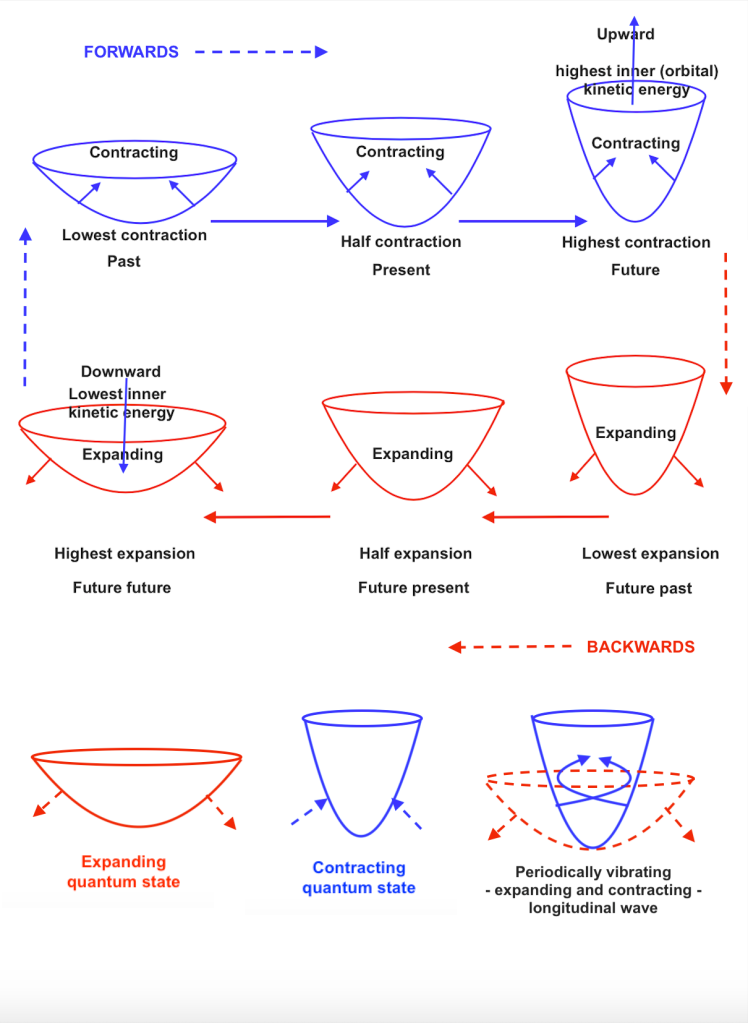
Considering it from the moment of its highest expansion, there will be a moment of no variation and then a moment when the wave will start to get contracted and that contraction will continue until reaching a moment when a highest contraction occurs. So, we can say that the initial quantum state of being highly expanded will evolve «forwards» to a next quantum state of being highly contracted.
Obviously this forwards evolution will not explain the total behaviour of the vibrating wave because it also will be necessary to consider its backward evolution from the quantum state of being highly contracted to the next quantum state of being highly expanded again. The whole behaviour of this quantum vibrating system is, then, cyclic.
But of corse, the backwards evolution, although it will bring us to the first or «past» quantum state of being highly expanded again, does not actually mean that we are coming back to the past from the future. If I open my closed hand and once it’s open I close it again, I will never think – at least that I had definitely lost my mind – that my closed hand has come from the future. It only will mean that the quantum states of being open or closed are being cyclically repeated.
Comparing the intermediate state of being partially expanding and the state of being partially contracting in its respective forwards and backwards «time lines», the shape of the vibrating wave, its amplitude and length, will be the same at those different moments, but its physical properties will be different: the direction of its inner kinetic orbital energy will be opposite, its inner orbital velocity will be respectively increasing or decreasing, and the inward and upward pushing forces in one case will turn out to be outward and downward pushing forces in the other case. (See in the below graphic the quantum states +2 and -2).
«TSVF combines causality both from the past (forward causation) and the future (backwards causation, or retrocausality). The two-state vector is represented by ⟨Φ| and |Ψ⟩, where the state ⟨Φ| evolves backwards from the future and the state |Ψ⟩ evolves forwards from the past.»
«The two-state vector formalism provides a time-symmetric description of quantum mechanics, and is constructed such as to be time-reversal invariant.»
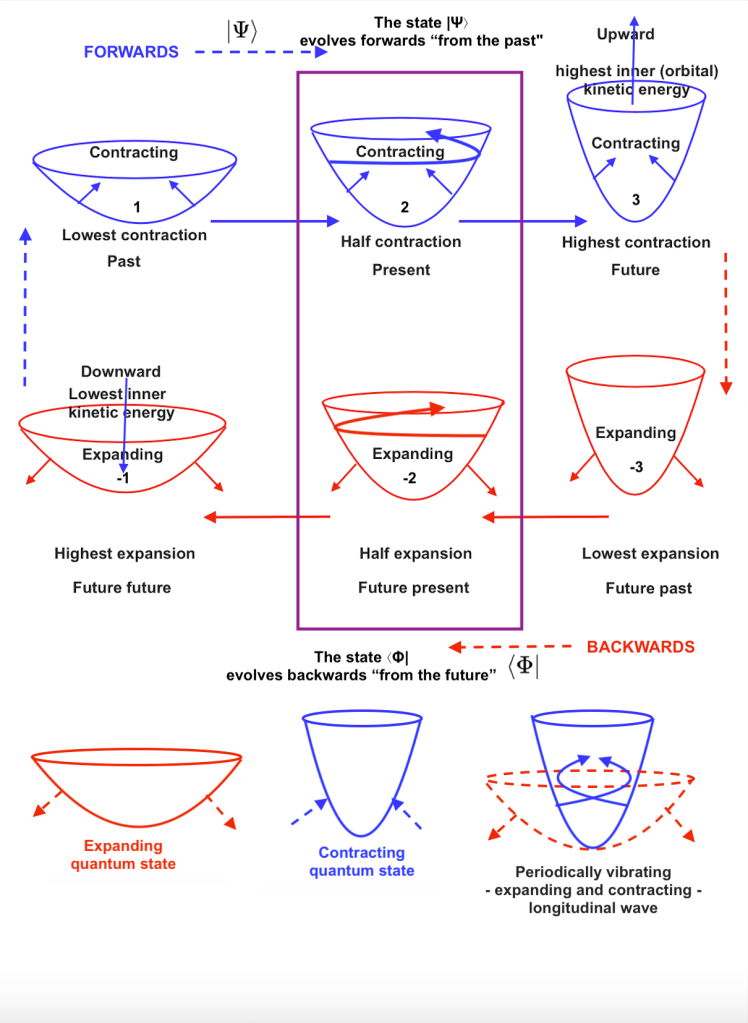
If we represent with numbers the cyclic (and invariant through time) quantum states described above, we can say that in this context +1|Ψ⟩ represents a past state with respect to +3|Ψ⟩ ; -3⟨Φ| will be past with respect to -1⟨Φ|; or +2|Ψ⟩ will be past with respect to -2⟨Φ|. (See the above picture). The time lines follow opposite directions.
But, again, this is only a metaphorical way of speaking. Because time is but the measure that we do of a variation. Such a variation that we measure can be the variation of space itself, the variation of an object moving from one point to another on a static space, the variation of an object moving from one point to another on a varying space, the variation of or in a subspace in a composite system of spaces and subspaces, etc.
What kind of variation are we speaking about when thinking in terms of quantum mechanics? That is the second thing that should be clarified, If we want to understand things rationally.
One of the main problems with quantum mechanics is that it did not have a geometric development, it has been developed by means of purely abstract algebraic equations and constant numbers whose meaning no one knows, without having visual geometric references. Physicists have no idea about the visual geometry of the atom, they agree about thinking in terms of diffuse clouds where their probabilistic equations can be applied without being troubled by rationalistic approaches that would radically protest if logical inconsistencies appear in their model or in the consequences that can be inferred from it. If a logical inconsistency appears, a rational mind – a utilitarian one will not – will try to look for its cause thinking that there must be still something we are overlooking (the famous «hidden variables») or misinterpreting.
However, when it comes to the geometry of the atom, one thing seems to be sure for all: a unique, independent and static field orbited around its center – a sort of heliocentric solar system model – it’s not valid to explain the atomic behaviour. That was the case of the first atomic model, the one tried by Bohr, which was rejected because it only was able to describe the Hydrogen atom with a single negatively charged electron and a single positively charged proton.
Even if the model is a vibrating longitudinal wave cyclically evolving forwards and backwards, it’s not going to be able to describe atoms. But, what about two intersecting waves that vary periodically, evolving «forwards» and «backwards»?
Here we can make the two quantum state vectors (vectors here indicate the time line), one coming from backwards and another one coming from forwards, in a same quantum state of being contracting or expanding:
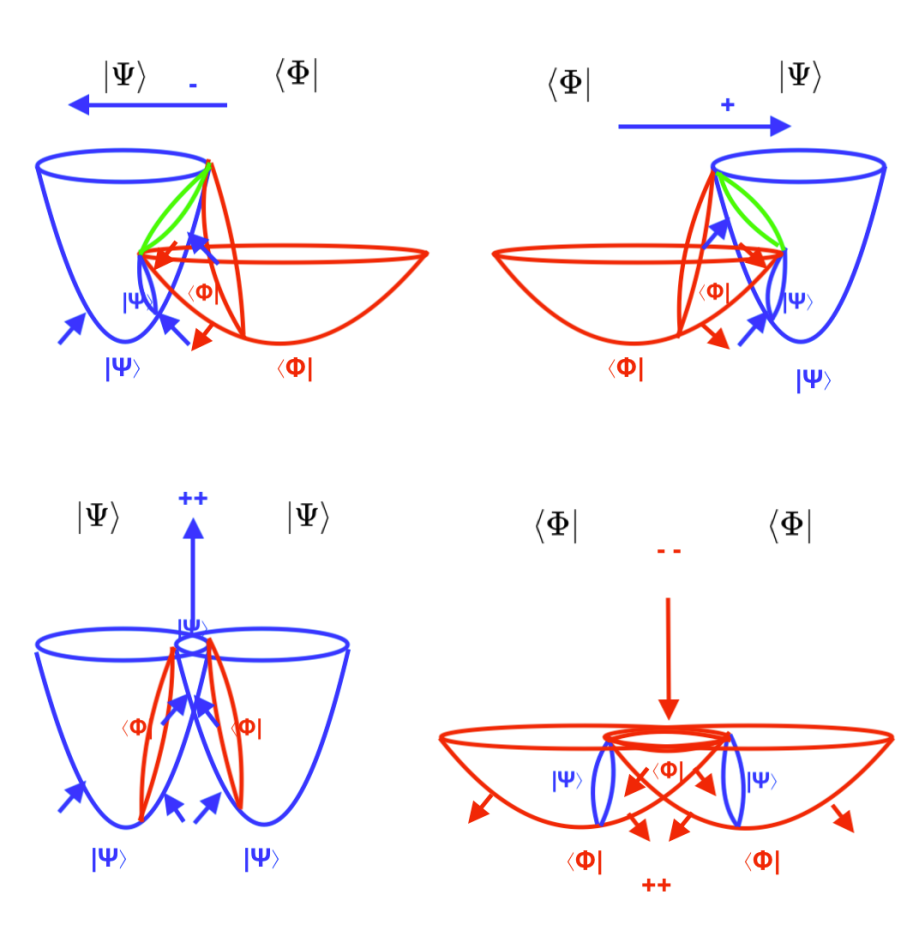
In this case we will have a composite system with two main time lines given by the phases of vibration of the intersecting waves that can be symmetric or antisymmetric between them, and two time sub-lines (or two secondary time lines) given by the phases of vibration of the subwaves shared by the intersecting dual system that will be symmetric or antisymmetric between them and symmetric or antisymmetric with respect to the two main time lines.
A composite dual system of this kind lets rationally explain why an electromagnetic charge is not a force of attraction or repulsion but the consequence of the left or right handed displacement of a subwave moving towards the side of the intersecting field wave contracts while the other one expands. It lets simply explain why positron and electron are the same «Majorana» antiparticle moving pendularly left to right (or «backwards» or «forwards» if you will).
It also lets explain how the proton will periodically decay; or why neutron and proton must be Dirac antiparticles at different successive times; or why fermions are ruled by the Pauli exclusion principle while bosons are not; or what’s the role of mirror symmetry when it comes to the Pauli Exclusion Principle and how can it be geometrically represented; or what quarks physically are in a context of composite vibrating waves and subwaves; or what supersymmetry between fermions and bosons is and how can it be mediated by quarks; or what extra space dimensions logically represent; or what chemical bonds are; or what strong and weak interactions consist in; or what antimatter is; or what dark matter and dark energy are; or how the Schrödinger cat can be dead and alive at the same time without being logically inconsistent, or how the quantum wave function «knows» it must disappear from a region just at the same moment that the particle it describes gets detected in another place (the «Einstein’s Bubble paradox)… or how it can be said that in quantum mechanics «present is caused by quantum states of the past and of the future taken in combination» as the «Two-state vector» interpretation states, without breaking with rationality.
A model of this kind would imply that the atom must be a composite system with a shared nucleus. The idea of a composite atom has been considered several times before, but the idea of a unique, independent and static field orbited around its center, the old geocentric and heliocentric spatial assumptions, still seem to remain deeply rooted in the subconscious mind of our physicists.
And when they verified they could not describe everything at microscopic level with a unique orbited field, they became radical iconoclasts for the shake or utilitarianism putting aside any visual geometric representation of the atomic structure, abandon rationality and focusing all their efforts in doing abstract probabilistic approximations and numeric and algebraic combinations.
[Something similar was made in mathematics when Greeks became aware that the diagonal inside of a referential square of root 1 could not be numerically described because it always gives non integer results. A limited segment would have a length with infinite decimals. Instead of realizing that maybe the problem was that we cannot measure everything with a unique referential square based on a unique and referential segment if we are working on different referential planes they decided to consider that irrational numbers were not actual numbers, breaking the connection between geometry and arithmetic. (when we rotate the Y coordinate towards Z we are introducing a new different plane on the same space with rotated X’Y’ coordinates and if we try to measure that rotated plane taking as reference the originary non rotated XY coordinates the actual effect is that, without being aware, we are going to be expanding the space and so changing the length of our referential segment)].
But let’s continue with the converging vector states:
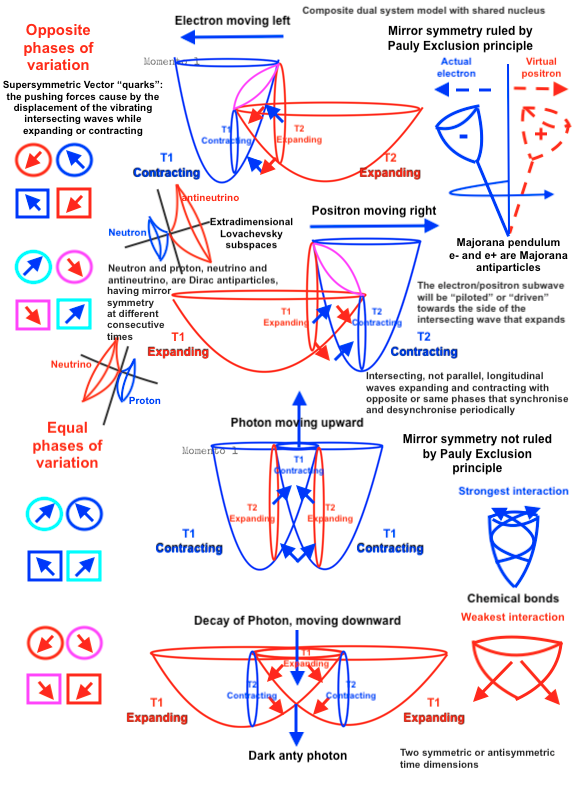
I think that to be able to causally and rationally understand quantum mechanics and to bring it a step forward beyond the standard model, it’s necessary to reconsider the current atomic model in terms of duality and to think about the atom as a dual composite structure.
Entanglement, superposition, or the Pauli Exclusion Principle must be interpreted in terms of mirror symmetry in a composite system, being aware that there will be at least two main time dimensions given by the same or different phases of variation of the intersecting waves and at least two secondary time dimensions given by the same or different phases of variation of the composite sub-waves.
That is the way I think this statement makes sense:
«In TSVF, causality is time-symmetric; that is, the usual chain of causality is not simply reversed. Rather, TSVF combines causality both from the past (forward causation) and the future (backwards causation, or retrocausality).»
I think this statement can be represented in this way:
The notions of past and future in this context make sense when it comes to a unique wave expanding and contracting; from a central present axis of symmetry, we could say that the previous state of being expanding is a past state, and the next state of being contracting is a future state.
The logic of this language gets inconsistent if we then say that the already contracting way (already in a future) starts to get expanded again, for us, as observers placed halfway between the past and the future, the wave’s status will evolve from the future contracting state to a past expanding state.
That kind of absurd reasoning, I guess could have been inferred because of the user of abstract equations managing the notion of time as if it were a positive or negative abstract symbol without any actual meaning.
Any case, the past and future states combination would occur when the intersecting waves vary with opposite phases; when it comes to equal phases, the combination of states will be both past or future:
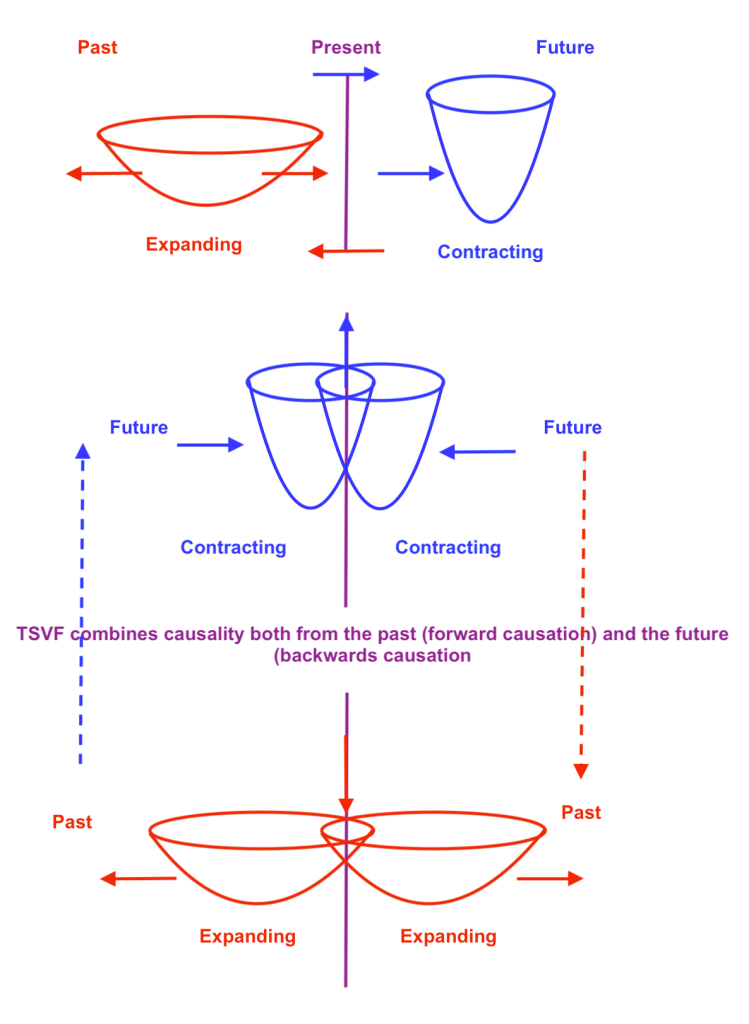
The interesting thing here is that when the phases of vibration are equal, when the combination is between two «past» states and later between two «future» states, we get the incoherent result that our «present» center of symmetry becomes or gets intercepted by the future itself or even by the past:
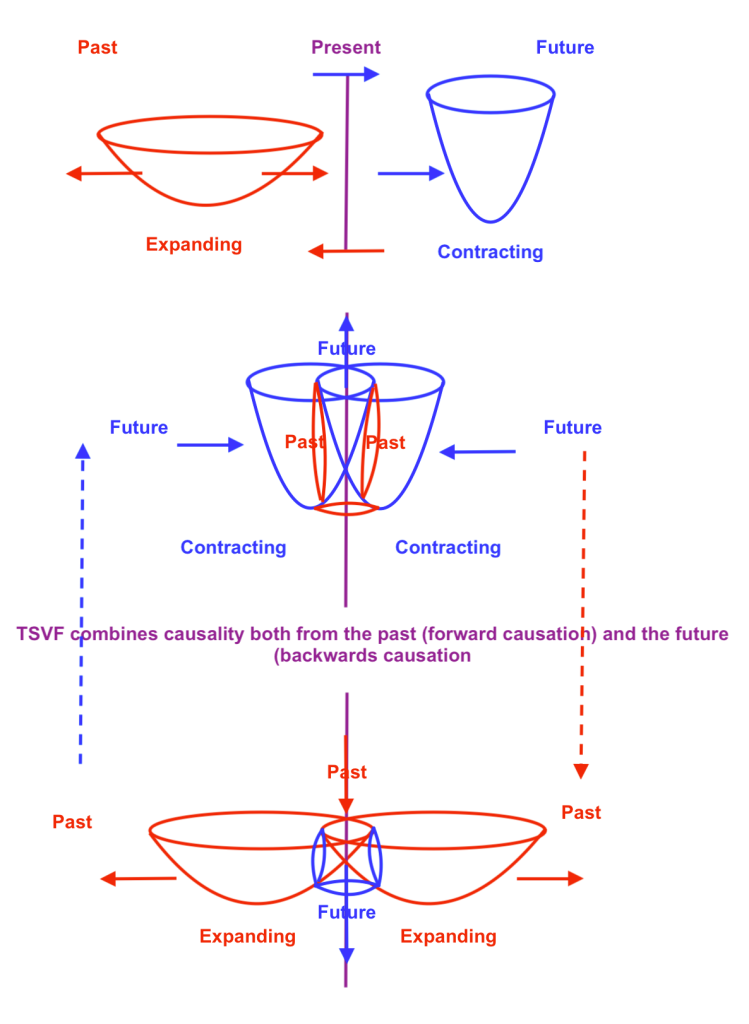
And the result is even more hilarious than that because in this case two «combined» future states not only will create a future state in the present line but also will create two past states in another different dimension (to describe the transversal subwaves we need additional spatial coordinates, they cannot be described with XY and X because in the transversal plane the Z coordinate acts as a Y coordinate). And in the same sense, two combined past states will create a past state in the present ando also two future states in other dimensions.
So here we would arrive to the crazy conclusion that not only a present effect can be caused by a combination of a past causal state and a future causal state, but also that two future states can cause in the present a future effect and, multidimensionally, two past quiral effects identical between them.
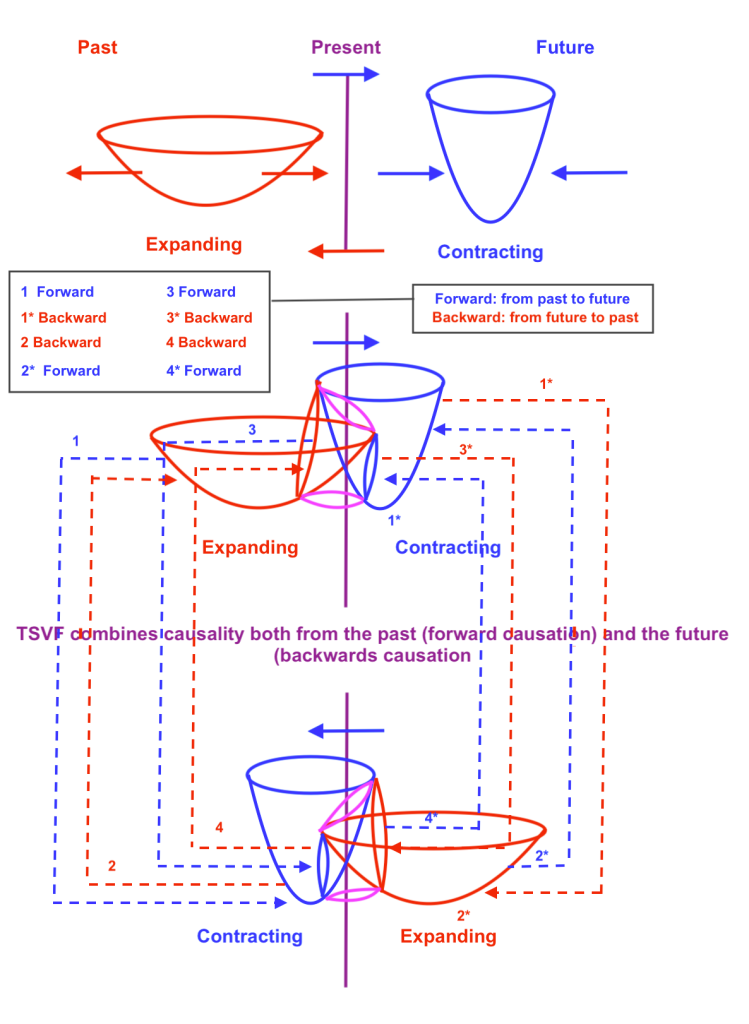
But lets to be clear one more time: we are speaking about quantum states that are cyclically repeated.
«Similarly as the de Broglie–Bohm theory, TSVF yields the same predictions as standard quantum mechanics. Lev Vaidman emphasizes that TSVF fits very well with Hugh Everett‘s many-worlds interpretation, with the difference that initial and final conditions single out one branch of wavefunctions (our world).»
The De Broglie – Bohm theory refers to the «wave pilot» interpretation of quantum mechanics. As the mainstream Copenhagen interpretation and the alternative Many Worlds interpretation, it’s also a probabilistic interpretation.
A composite model of intersecting spaces and subspaces that vibrate can logically explain a wave pilot in a local and causal way; But to do that it will be necessary at least two intersecting wave pilots. So, for example, in the case that the intersecting longitudinal waves vibrate with opposite phases, the electron/positron subwave will be driven or piloted towards the side – left or right – of the intersecting wave that contracts. It’s the intersection of wave pilots what forms the nuclear subwaves, and it’s the vibration of the intersecting wave pilots what will determine the physical properties, displacements and behaviours of each nuclear subwave.
I think in this sense the notion of «wave pilot» can be related to the string theories that consider that mass and physical properties of the subatomic particles are cause by the vibration of strings. But I think are intersecting wave pilots – instead of strings – what vibrate.
A dual atomic model of intersecting waves can also explain in a causal, local, and rational way the Everett’s Many Worlds interpretation by thinking in terms of intersecting, not parallel worlds (here the term «world» is used in a general way and it can be related to fields or universes). The multiverse cannot be about parallel universes but about intersecting universes that create pairs of mirror symmetric sub-universes, having mirror symmetry at same or different times.
«The two-state vector formalism has similarities with the transactional interpretation of quantum mechanics proposed by John Cramer in 1986, taking inspiration from the Wheeler-Feynman Time-symmetric theory or absorber theory« (also known as «direct action» theory).
This is pretty interesting. Let’s have a glimpse at the John Cramer‘s «Transactional interpretation» as well:
«The transactional interpretation of quantum mechanics (TIQM) takes the wave function of the standard quantum formalism and its complex conjugate, to be retarded (forward in time) and advanced (backward in time) waves that form a quantum interaction as a Wheeler–Feynman handshake or transaction.»
Can we apply as well the notions of «retarded» forward in time and «advanced» backward in time to the two vector state interpretation? I mean without become crazy. It’s interesting they use those concepts because when apply them to the composite dual system we see they can be used to metaphorically explain the synchronization and desynchronization of the phases of vibration of the intersecting waves that would form the composite atom. This «advance» or «delay» is what explains how fermions and bosons are supersymmetric linked, even more, how bosons become periodically fermions and viceversa. We will see it later in a more detailed way. Now let’s attach the diagrams of the retarded and advanced quantum states:

«The existence of both advanced and retarded waves as admissible solutions to Maxwell’s equations was explored in the Wheeler–Feynman absorber theory. Cramer revived their idea of two waves for his transactional interpretation of quantum theory. While the ordinary Schrödinger equation does not admit advanced solutions, its relativistic version does, and these advanced solutions are the ones used by TIQM.«

«In TIQM, the source emits a usual (retarded) wave forward in time, but it also emits an advanced wave backward in time; furthermore, the receiver, who is later in time, also emits an advanced wave backward in time and a retarded wave forward in time. A quantum event occurs when a «handshake» exchange of advanced and retarded waves triggers the formation of a transaction in which energy, momentum, angular momentum, etc. are transferred.»
The image of «handshaking waves» closing a transactional agreement is a symbolic way of speaking. Although they arrived to the conclusion that there must be a kind of meeting between waves, they still don’t know the physical mechanism that is given by the waves’ intersection.
«Ernst Stueckelberg, and later Richard Feynman, proposed an interpretation of the positron as an electron moving backward in time, reinterpreting the negative-energy solutions of the Dirac equation. Electrons moving backward in time would have a positive electric charge».
John Wheeler invoked this concept to explain the identical properties shared by all electrons, suggesting that «they are all the same electron» with a complex, self-intersecting world line.
He said «with a complex self intersecting world line», didn’t he? ok. It was only to be sure. I’m going to repeat it again then: «WITH A COMPLEX SELF INTERSECTING WORLD LINE».
«Yoichiro Nambu later applied it to all production and annihilation of particle-antiparticle pairs, stating that «the eventual creation and annihilation of pairs that may occur now and then is no creation or annihilation, but only a change of direction of moving particles, from past to future, or from future to past.»
I’d like to have a conversation with these people but sadly most of them already died. If they were alive, they probably would have never responded anyway, because they did not have any visual geometric reference and this kind of non probabilistic model would have seemed too strange to them. they would have not been used to discussing in conceptual terms either and making «translations». But i can write here the email I would send them:
Dear professors:
I’d like to ask you if you have ever considered the possibility of a composite atom.
I’m not a physicist, but I think that a dual model of two intersecting longitudinal waves vibrating with same or opposite phases would let clarify the atomic structure in quantum mechanics.
In such a model, the atomic nucleus would be composed by the orthogonal and transversal sub-waves that are formed by the two intersecting waves.
For example, having opposite phases, if the left intersecting wave contracts while the right handed one expands, the shared orthogonal sub-wave will move to the left and, a moment later, when the left intersecting wave expands while the right handed one contracts, the orthogonal subwave will move towards right. The pendular left to right and right to left displacement of the orthogonal subwave is not caused by any force of attraction or repulsion but because the variation of the curvatures of the two intersecting waves while they vibrate: the orthogonal subwave will be always displaced towards the side of the intersecting wave that contracts.
If we call «electron» to the orthogonal subwave moving towards left, we can call that same subwave «positron» when moving towards right. In that sense, the electron will be its own antimatter when acting as positron and viceversa; so, the electron/positron subwave will be a Majorana antimatter.
You will be aware that professors Stueckelberg and Feynman proposed an interpretation of the positron as an electron moving backward in time, reinterpreting the negative-energy solutions of the Dirac equation. Electrons moving backward in time would have a positive electric charge.
Thinking in terms of vibrating waves, it can be thought that when a longitudinal wave is contracting its spatial variation moves forwards in time, and when later it gets expanding it will move backward in time, and so on in a periodical way. But a single wave is not enough to generate electromagnetic charges. EM charges, electronegativity and electropositivity, are not intrinsic properties that matters have per se, they simple consequence of the periodical variation of a composite spatial system. In the same way Einstein clarified that the gravity is not a force of attraction but the curvature of a space, (I will discus this statement later), geometrizating the newtonian force, electromagnetic forces would be consequence of the periodical variation of the curvatures of a dual composite spatial system.
This pendular electron/positron subwave would also have a circular rotation because the whole composite system would rotate around its center as consequence of a precession effect. So, there would be only one electron/positron subwave moving around the central axis of the system.
You surely will know that professor John Wheeler suggests that all electrons share the identical properties simply because «they are all the same electron«.
Continuing with the composite atomic model of intersecting longitudinal waves, which I think is a quantum field model, you well see there’re also two transversal subwaves, expanding and contracting, following the phase of vibration of the intersecting wave they are close to. So, if the left intersecting wave contracts while the right handed one expands, the left transversal subwave will contract and the right transversal subwave will expand.
The left and right transversal subwaves are Dirac antimatter of each other but at different times. The fact that they do not have mirror symmetry at the same but different moments times will be a consequence of the Pauly Exclusion Principle. I think the PEP must be understood in terms of mirror matter. The quantum state of being contracted of the left transversal subwave cannot materially occur while the right transversal subwave is in the quantum state of being contracted, and viceversa. It’s materially impossible.
The PEP also rules the orthogonal electron/positron subwave, because its quantum state of being displaced towards left or right is materially incompatible with the quantum state of being displaced at the same moment towards right or left.
I think the left contracting transversal subwave could be called «neutron» and the coexistent right expanding subwave could be called anti-neutrino. In that same sense, a moment later, the left expanding transversal subwave could be called «neutrino» and the coexistent right contracting subwave could be called proton.
So, the left transversal neutron would decay into a left transversal neutrino while the right transversal antineutrino evolves into a right transversal proton; and later, the left neutrino will evolve again to a left neutron while the right proton will decay again into an antineutrino.
Neutron and proton (as neutrino and antineutrino) would be mirror symmetric antiparticles at different successive times. There would be also a unique neutron/neutrino and a unique proton/antineutrino transversal subwave moving in a rotational wave with the whole composite system around its center.
As you will know, Heisenberg already suggested that neutron and proton could be antiparticles, but later measures rejected this idea because it seems they have slightly different masses. But you will also be aware that the current standard model has not been able yet to explain why the proton’s decay occurs.
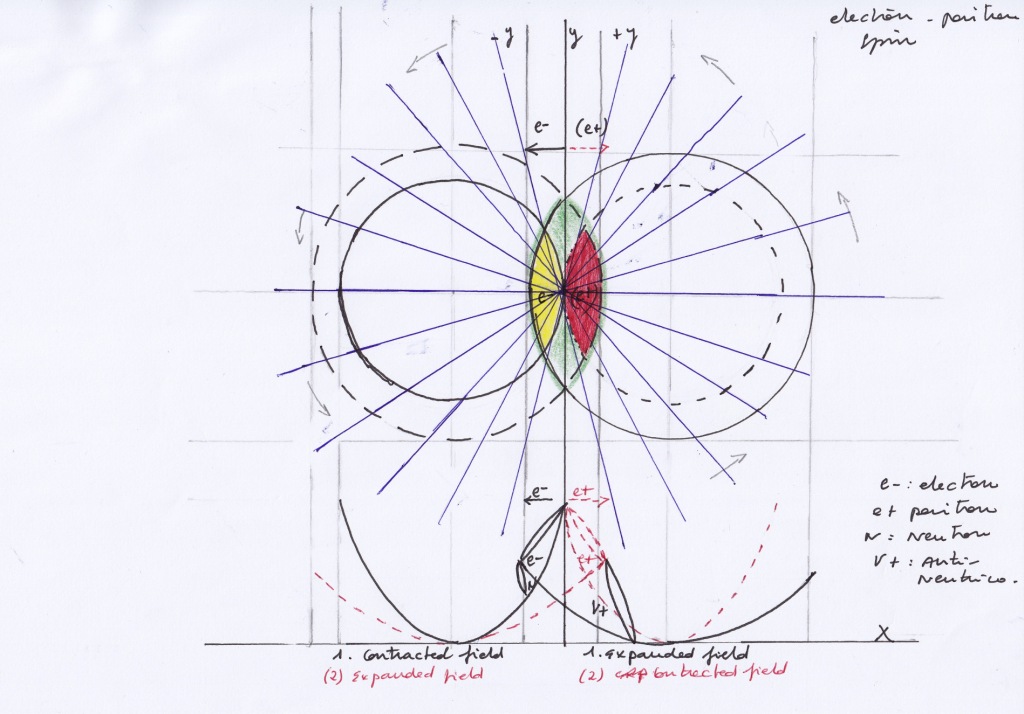
On the other hand, when the phases of vibration of the intersecting waves synchronize becoming equal, the orthogonal and transversal subwaves that form the nucleus shared by the intersecting dual system will get different shapes, different material properties (in terms of pushing forces and inner kinetic energies) and different displacements.
When the phases of vibration of the intersecting waves are equal, the electron/positron orthogonal subwave will not move left to right but upwards and downwards.
So, when both left and right intersecting waves contract at the same time, the orthogonal subwave will experience a double inward force of pressure from right to left and from left to right (acting as an electron/positron subwave it only experienced a single left or a right from right or left force of pressure), getting contracted and accelerating its inner kinetic motions, and having an upwards displacement that will cause an ascending pushing force. A double helix will be formed.
A moment later, when both left and right intersecting waves expand at the same moment, the upwards orthogonal subwave will experience a double decompression getting expanded and decelerating its inner kinetic orbital motions, causing the loss of the previous ascending pushing force.
Now, an inverse pushing force will be taking place at the convex side of the intersecting waves, which will be undetectable, hidden or «dark» to an observer located at the concave side of the system.
I think the pulsation caused by the orthogonal contracting and ascending subwave can be called quantum «photon», and the lost of force and energy caused by the expanding and descending subwave cold be call a quantum «decay».
The Pauli Exclusion principle rules this photonic subwave when considering only the concave side of the system, because the photon and its decay cannot exist at the same moment, and it also rules it when considering both the concave and the convex realms of the system because the photon cannot exist (at the concave side) at the same moment than its mirror symmetric dark antiphoton (at the convex side).
Notice that the quantum discontinuity would become continuous if we considered both the concave and the convex sides of the system, if considering the photon and its mirror symmetric dark antiphoton.
But the Pauli Exclusion principle does not rule the left and right handed transversal subwaves when the phases of vibration of the intersecting waves are equal: when the left and right intersecting waves contract at the same moment, the mirror symmetric left and right transversal subwaves will simultaneously expand; and when a moment later the left and right intersecting waves expand at the same moment, the mirror symmetric left and right transversal subwaves will simultaneously contract.
The state of being expanded of the left transversal subwave violates the PEP because it’s actually compatible with the state of being expanding of the right transversal subwave at the same moment. In the same sense, a moment later, the left and right transversal subwave will have at the same moment the state of being both contracting.
I think the Pauli Exclusion Principle, overlapping, and entanglement must be reinterpreted in terms of mirror matter.
I’m not sure if the expanding transversal subwaves can be called in this case «electronic neutrino» and «electronic neutrino». I don’t know how to name the contracting transversal subwaves in this case.
It’s interesting to notice that when the phases of vibration of the intersecting waves are equal, the bosonic left and right transversal subwaves will follow an opposite phase of vibration with respect to the phase of vibration of the intersecting waves. But the fermionic orthogonal subwave will follow the same phase of vibration that the intersecting waves.
(Remember that when the phases of vibration of the intersecting waves are oposite, the left and right fermionic transversal subwaves and the fermionic orthogonal subwave follow the same phase that the intersecting wave they are close to).
It seems then it can be spoken about symmetric and antisymmetric times dimensions. To fully describe this composite system several converging and diverging time dimensions must be considered.
The periodical evolution of fermions into bosons and bosons into fermions will occur when the phases of vibration of the intersecting waves desynchronize or synchronize periodically. It’s not necessary to look for different kind of unknown subwaves to explain how the symmetry of bosons and fermions is linked through time, we can represent supersymmetry in terms of vectors of force that will periodically permute when the intersecting waves periodically expand or contract. We can name those symbolic vectors that represent the pushing forces caused by the displacement of the expanding or contracting intersecting waves as «quarks».
Supersymmetric quarks could also be considered to clarify the gap mass problem in a context of composite dual system of intersecting longitudinal waves whose phases of vibration synchronize and desynchronize periodically:
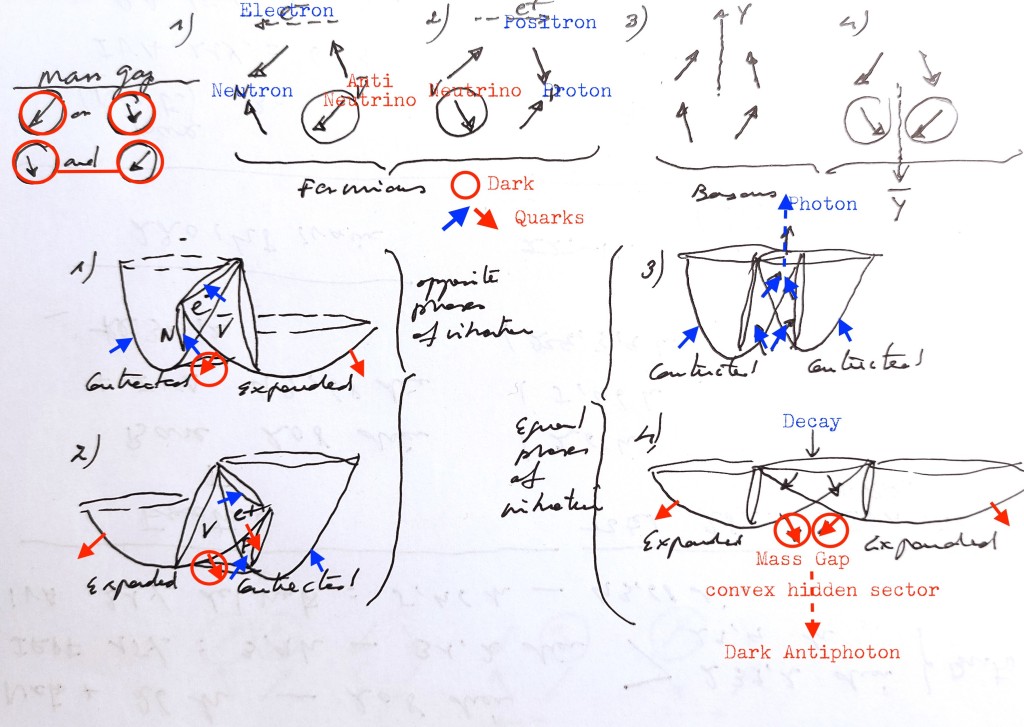
I think this kind of composite model also lets clarify the De Broglie – Bohm pilot wave interpretation from a local, causal and non probabilistic perspective. In this sense, for example, it could be said that the electron/positron subwave is piloted or driven towards left or right, varying their physical effects, the right (positive) or left (negative) pushing forces caused when getting pendularly displaced, and the direction of their inner kinetic motions, by the quantum state of being expanded or contracted of the dual intersecting waves that form it. it’s the variation of the intersecting pilot waves what determine the shape, behaviour, physical properties and location of the subwaves (or subatomic particles) that form the nucleus shared by the dual atomic system.
It also could help clarify the Everett Many Worlds interpretation if thinking in terms of intersecting – not just parallel – worlds, fields, or universes.
In cosmological terms, the model of a unique, independent and static field orbited around its center is very well stablished and remains unquestioned since a long time. But the heliocentric model is not able to explain in a mechanical way the multiple detected asymmetries: every planet has a different inclination, each planetary orbit has different eccentricity, planets accelerate and decelerate periodically having all different velocities, and even some planets rotate in an opposite direction. Although these asymmetries are mathematically described, the current solar system model in its apparent simplicity can be thought as monstruos sculpture formed by the very different and unrelated members of different creatures. Such was the same thought that made Copernicus suspect that geocentric model could be a non accurate description of nature.
A model of composite spaces and subsapces would help explain a universal big bang in terms of the pushing force caused by an orthogonal subwave moving upwards. Moving downwards, the pulsating big bang would be followed by a big silence in the concave side of that composite multiverse and an inverted big bang at its convex side.
With respect to the Schrodinger cat paradox, I think it’s necessary to reconsider it under the light of a composite atomic model. The same fermionic cat cannot be dead and alive at the same moment, but what about a cat that is alive and appears dead when looking itself at a mirror?
For example, the left transversal cat is contracting-alive, but looking at the right transversal cat – expecting that it will be its mirror symmetric reflection – it appears expanding-dead.
It should not surprise us because knowing that the intersecting waves have opposite phases of vibration, if the left intersecting wave is contracting, the left transversal cat will be also contracting-alive and its right mirror reflected cat is expanding-dead.
it’s because the left and right transversal cats are the mirror reflection of each other at different times, as if the left cat were in the present and its mirror reflection cat were in the past or the future.
But speaking in these terms of being dead and alive, or being in the present or in the past or future, is a metaphorical way of speaking that should not be literally taken.
There’s not a unique cat, nor a unique cat and its mirror reflection; there are two cats that result to be coincident in a mirror symmetric way at different successive moments.
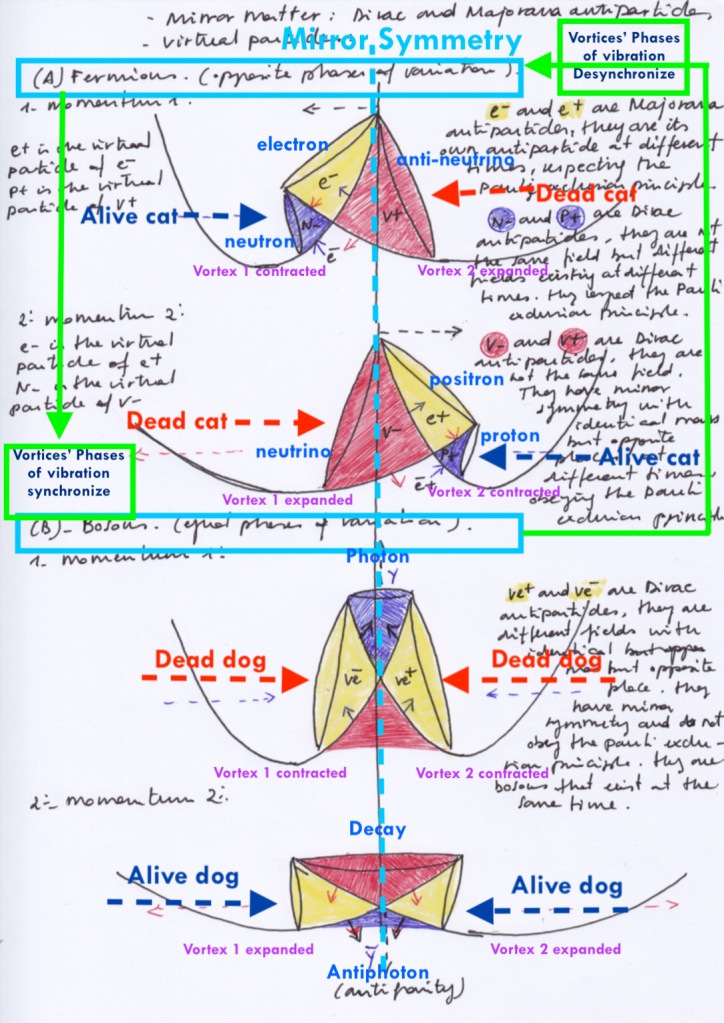
When the phases of vibration of the intersecting waves synchronize, the left and right transversal subwaves will get different shapes and properties than before, evolving from so the fermionic cats to bosonic cats or bosonic dogs if you will. The bosonic dog and its mirror symmetric reflection will be both contracting-alive or both expanding-dead.
The double and simultaneous state of being dead and alive is a simple consequence of the Pauly Exclusion Principle. The Schrodinger paradox results to be a very reasonable thing in this perspective.
With respect to the mathematical typification of the transversal subwaves, you can get a clue when looking to the Calaby-Yau and the Kaluza-Klein transversal geometry. The two next pages are taken from prof. Yau’s book «The Shape of inner Space:
The transversal subwaves are extradimensional because we can not describe those spaces by means of the XY and Z referencial coordinates that we use to describe the intersecting waves. The Y coordinate of the transversal subwaves will be the Z coordinate of the intersecting subwaves.
The transversal subwaves could also be related to the Lobachevsky imaginary geometry:

Additional notes – – – – – – – – – – – – – – – – – – – – – – – – – –
- https://en.wikipedia.org/wiki/Two-state_vector_formalism
- https://en.wikipedia.org/wiki/Transactional_interpretation
- https://en.wikipedia.org/wiki/Retrocausality
(«Retrocausality, or backwards causation, is a concept of cause and effect in which an effect precedes its cause in time and so a later event affects an earlier one. In quantum physics, the distinction between cause and effect is not made at the most fundamental level and so time-symmetric systems can be viewed as causal or retrocausal.»)
https://www.geekwire.com/2020/physics-professor-tackles-one-mystery-quantum-mechanics-times-flow/
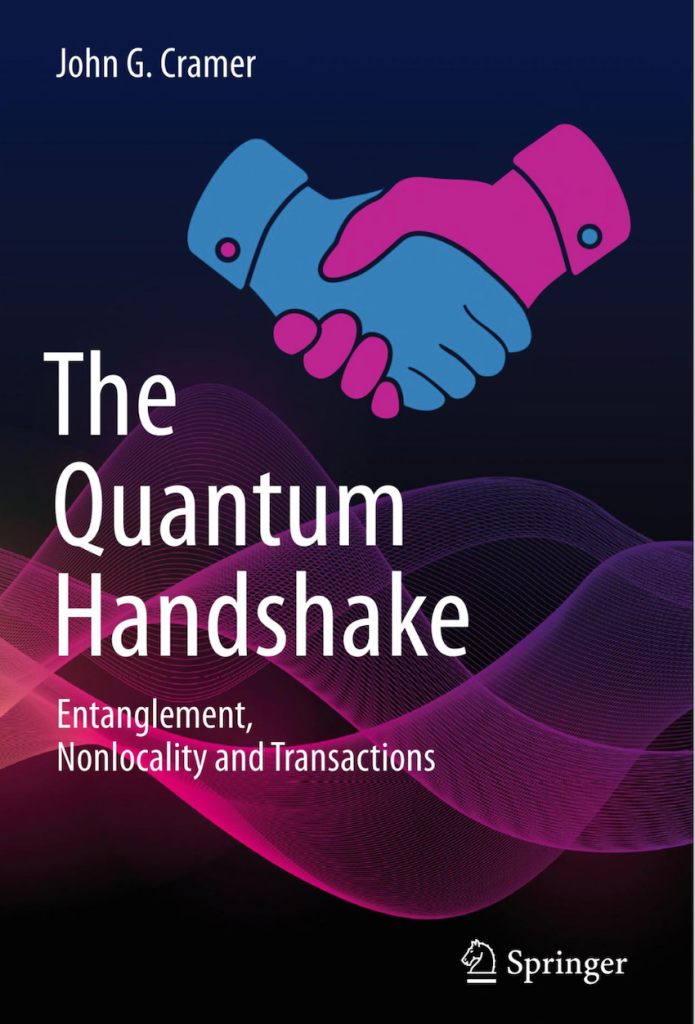
In the next interview prof Cramer is asked about summarizing his book «Quantum Handshake» where he explains his Transactional interpretation of Quantum Mechanics:
«First of all, in Quantum Mechanics there’s a thing called the wave function and if you look at the mathematics of Quantum Mechanics you find that the wave function and its complex conjugate appear equally in various places on its mathematics.
The transactional interpretations interprets the complex conjugate of the wave function as being the mirror image of the wave function which is moving backwards in time and it represents that quantum advance has been a handshake between the wave function and its complex conjugate so called advanced and retarded waves.
These ideas came from a work by Wheeler and Richard Feynman published in 1945 which was trying to do something with electrodynamics using more or less these ideas. I came across when I was a graduate student and many years later it occurred to me that the same ideas could be applied to quantum mechanics.
So the book basically lays out the history of quantum mechanics and this idea of transaction as the sort of key element that’s been missing on understanding all the paradoxes and peculiar situations that one finds in Quantum Mechanics.»
https://www.podbean.com/ew/pb-zccqz-c6630d
https://www.podbean.com/ew/pb-zccqz-c6630d
Notice that a wave function and its mirror symmetric complex conjugate wave function can be represented in this way:

When the delay of the complex conjugate wave occurs, it can be represented in this way:
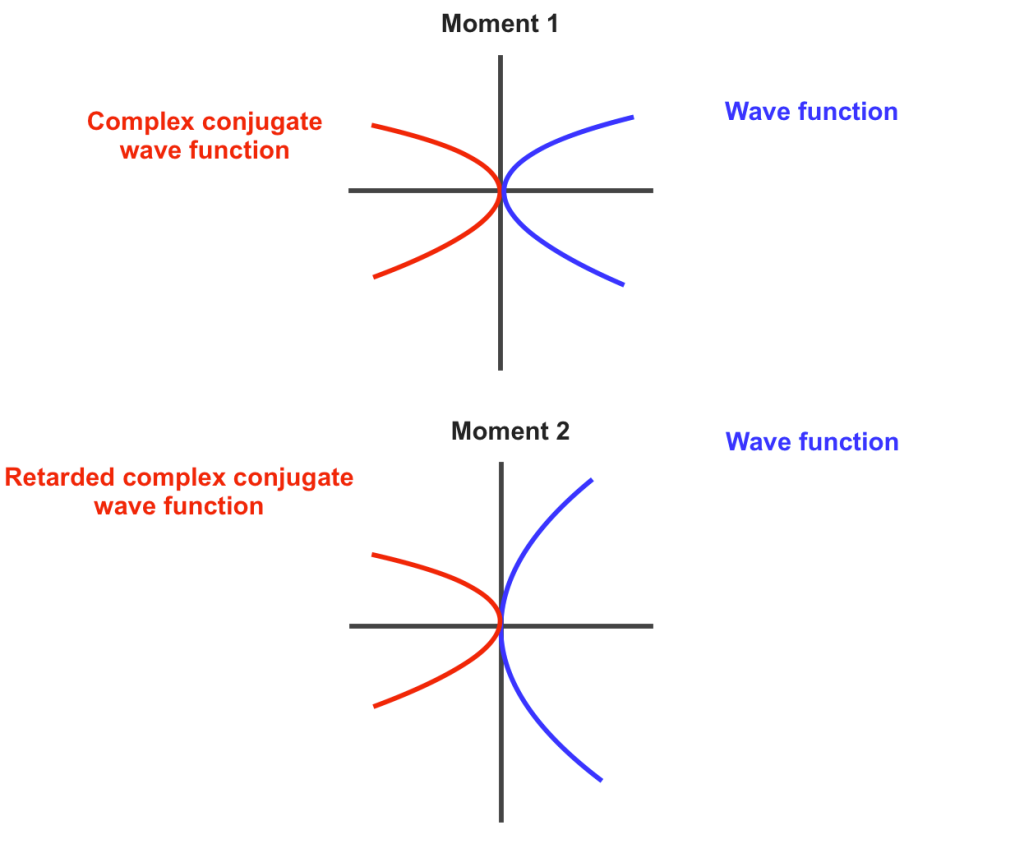
You can see then that when the «delay occurs» at moment 2, the wave function and its complex conjugate function are not mirror symmetric but mirror antisymmetric.

Notice that when the delay of A’ happens (it should be expanding being the mirror symmetric wave of B’), the subwave that gets retarded is not c’ but d’ (which is placed at the left handed side with respect to the center of symmetry of the system).
But the trickiest thing here is that when A’ gets retarded causing the delay of d’, the physical properties of the transversal c and d pair change (and also will change the physical properties of the orthogonal subwave) as we saw through this post.
Using the «transactional» interpretation terminology, the «emitters» and «absorbers» waves that close a transactional agreement through a «handshake», giving or taking between them their physical properties as kinetic energy, density, volume, forces of pressure, etc. – as if it were a commercial agreement where they interchange things, taking place a present meeting between retarded future or advanced past waves, we can represent it with this next diagram:
Or a more complete diagram:
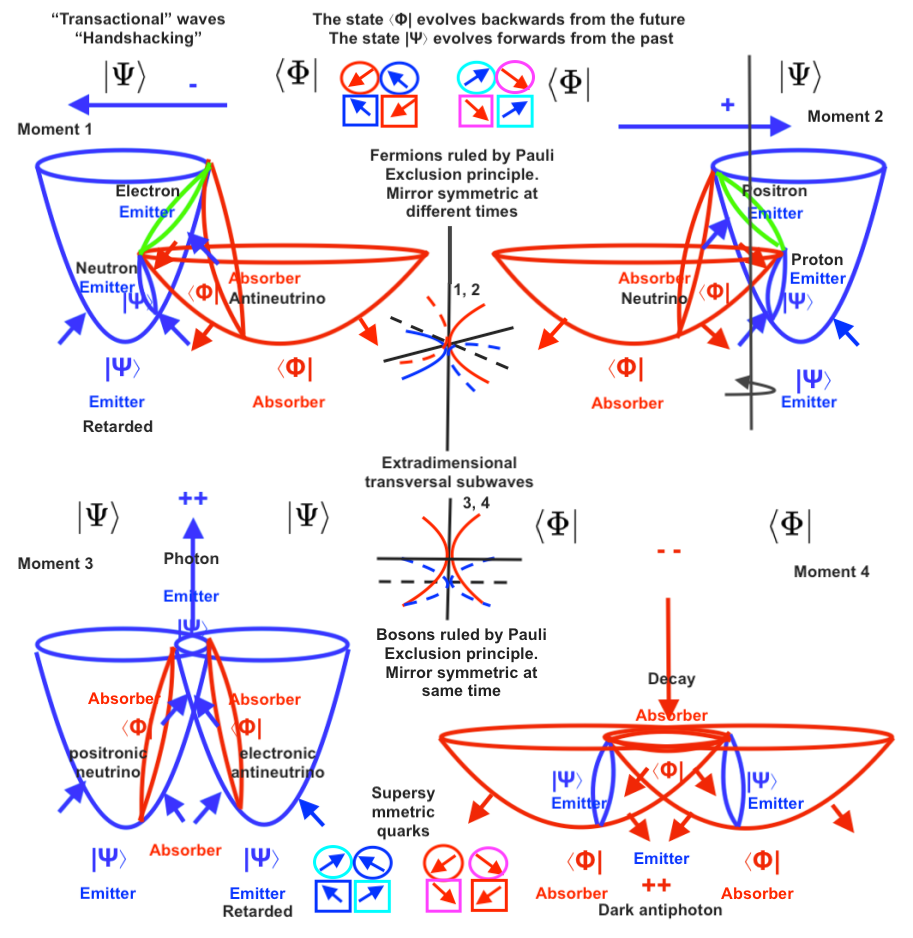
Another physicist that currently follows the Transactional interpretation is Ruth Kastner:

In this interview she speak about transactional interpretation showing the extent of what they know and don’t know:
A very interesting part to me is when she speaks about the Max «Born rule», which is something that I didn’t know. 4′:047′
«Back in the early days of Quantum Theory, when you wanted to try to predict what’s the likelihood or probability the probability that you’re going to find your system in a particular state later or at a particular detector in an experiment, it turned out that you couldn’t just look at this quantum state of wave function and the size of it that is called the amplitude, you had to actually square it, you had to take this wave function – which was a complex number – and take its complex conjugate and multiply them together and get a number that then made sense as a probability. So, it was Max Born who realized, you know, at one point in 1931 in a foot note in a paper he wrote that, «oh! it’s not the size of the wave function, I have to square it», you must square it to get the probability. So it was kind of a mysterious rule that was named after Max Born and it worked; but it seemed a bit «ad hoc», it seemed as though people didn’t understand where it came from»…
«Other reasons that John Cramer wanted to pursue his idea, what appealed to him immediately and also to me when I was learning about it, was that this mysterious Born rule just kind of came out of the dynamics of this picture» (the dynamics of the transaction of energies, etc, between the two wave functions).
Take a look at the Born rule on Wikipedia: https://en.wikipedia.org/wiki/Born_rule
where it’s said that «it is common to describe the Born rule as saying that probability is equal to the amplitude-squared (really the amplitude times its own complex conjugate)».
So, the transactional theory lets make sense about the fact that the amplitude of the weave function (its curvature) must be multiplied by the amplitude of its complex conjugate (its mirror symmetric wave).
So, this can be considered as clue about the atom being a dual a composite structure of two waves.
The Born rule is very interesting because when it comes to gravity, distance must be also squared. Currently, a unique, independent and static gravitational field orbited around its center cannot explain all the asymmetries detected. A gravitational could not explain them either. Is the gravitational rule that appears in Newton and Einstein gravity be a clue to reinterpret gravitational fields as a part of a composite system? No one knows why distance must be multiply by itself.
On the other hand, before finishing for now, it’s also interesting this prof. Cramer’s paper:
https://www.mdpi.com/2073-8994/12/8/1373/htm
Look at this picture it has attached: Aren’t we speaking about the same?
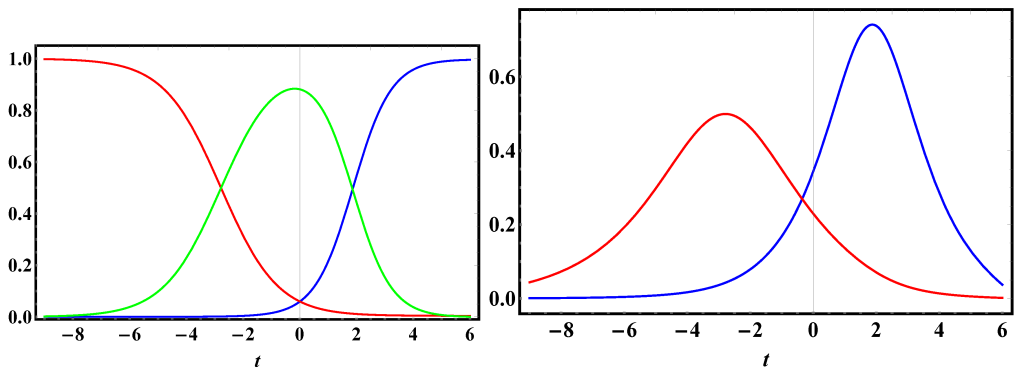
The Schrodinger wave function is a second degree differential equation. I have no idea about differential equations, but the question that comes to mi mind is: why are not they considering the first degree wave functions? Because it seems they are only considering the subwaves that form the atomic nucleus – which should be of a second degree, but clearly are not being aware about the intersecting waves that would form it, being those intersecting waves of a first degree. That’s why they need to use statistical approximations and they change the whole system when trying to measure a part of it. The Heisenberg indetermination principle should be called the Heisenberg «deterministic» principle.
The question about the above diagrams is what do those two functions, the wave function and its complex conjugate function, represent?
If we think about subatomic particles as vibrating fields or longitudinal waves, (they would be «subfields» or «subwaves), the wave function would represent the variation of the particle quantum state of being contracting or expanding through time. That variation will give us the amplitude of the wave at a specific moment, the variation of its curvature at a specific time. The variation of the curvature of the subwave will determine the change of its physical properties and so its evolution into another kind of subwave with different physical properties.
I think the complex conjugate wave function represent the variation of the curvature or quantum state of a particle that is mirror symmetric or antisymmetric of the another particle at the same or different moments.
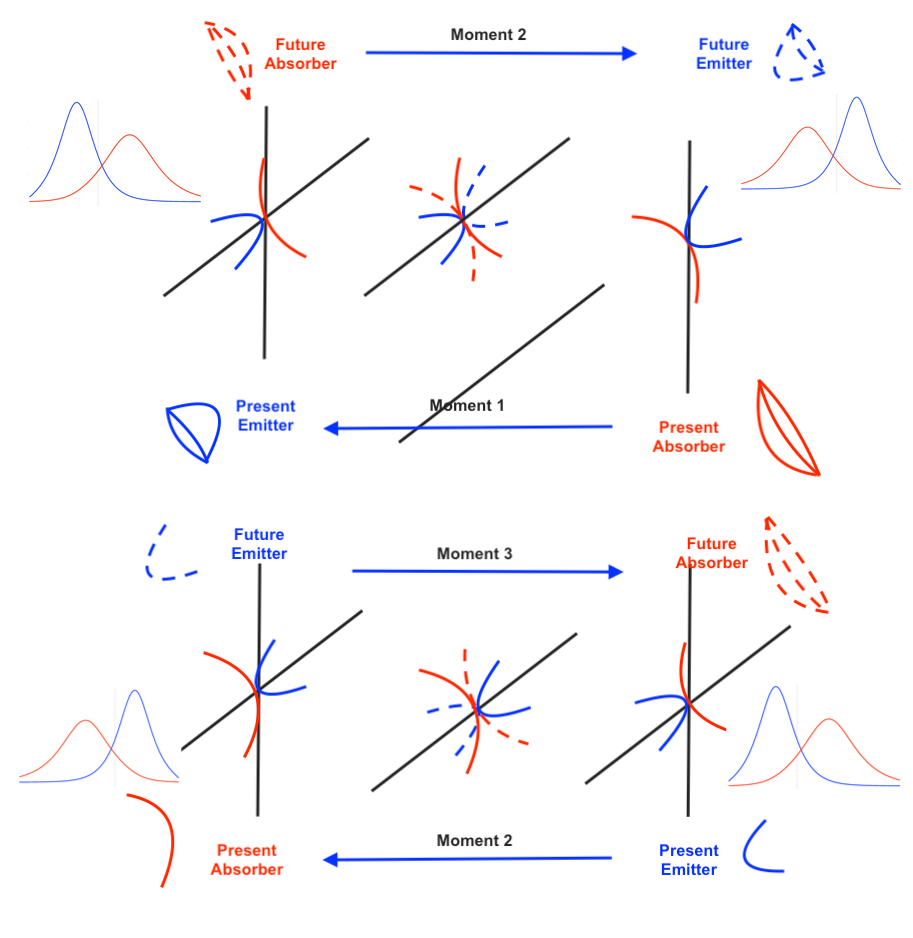
Although prof. Cramer’s diagram represent the wave functions intersecting I think it’s only trying to represent a subwave of the system and its complex – mirror symmetric – counterpart at same moment. When the phases are opposite the complex conjugate will not be mirror symmetric (contracting vs contracting or expanding vs expanding) but mirror antisymmetric (contracting vs expanding or expanding vs contracting).

The above picture doe snot represent the intersecting waves but only the subwaves, but we can infer that they have opposite phases of vibration. So here the transaction happens between the contracting and the expanding subwave. The inner kinetic energy, the forces of pressure, or the density that are lost by the expanding subwave are taken at the same moment by the contracting subwave.
But the subwaves are extradimensional because their Y coordinate correspond to the Z coordinate of the intersecting waves. To consider both grades of hierarchical waves, something like this sohould be considered:

Reading some critics about the transactional theory, some people complain that the transactional mechanism is something abstract. Actually, the interpretation does not use a properly physics language but an economic or commercial one.
It would be more accurate to speak about how one subwave «evolves» or «decays», into another one acting as another kind of «particle» when its quantum state changes through time.
But I think it’s a very good advance towards the realization that the atom is a composite structure. I’m very happy I found Watanabe and Cramer developments. I wish I had meet then before.
Taking a look at the Cramer’s book, you can find this paragraph at its initial pages:
«Wheeler and Feynman had constructed a time symmetric formalism and then used real boundary conditions involving future absorbers to justify causality and the arrow of time that we observe in the real world».
I think this can be represented in the next way:
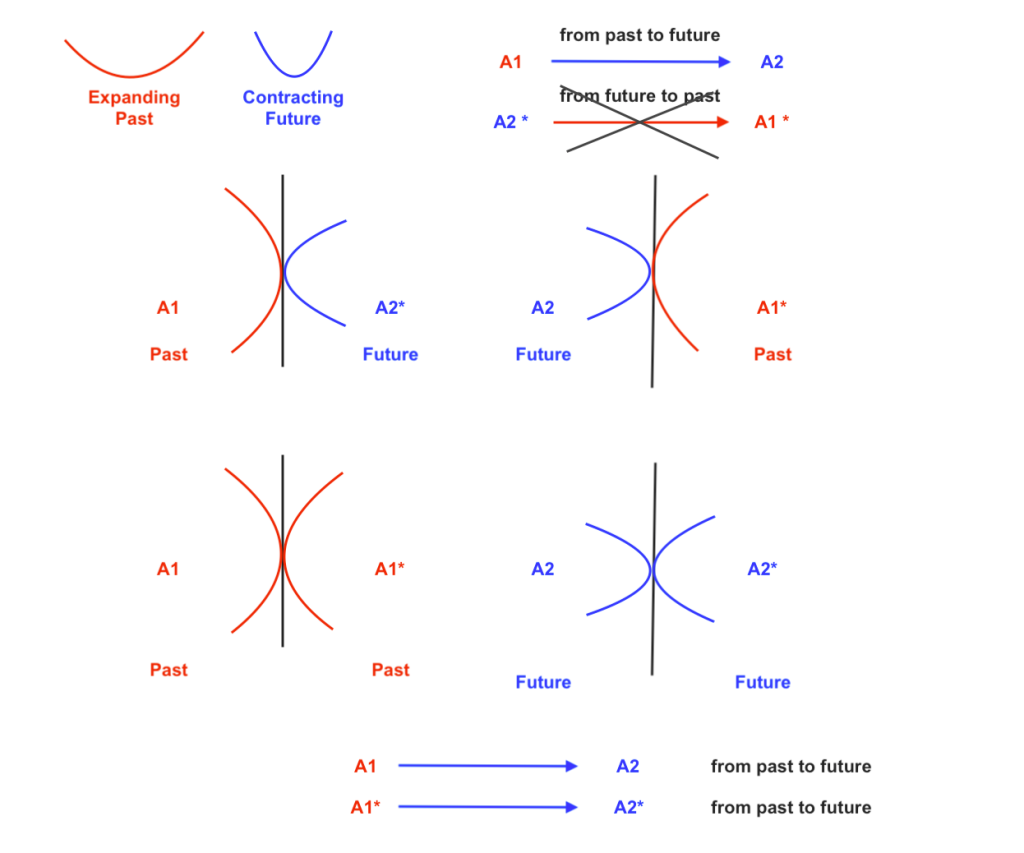
As from a «classical» causal point of view a negative or backwards time of line (from future to past) would not be possible, they looked for the time symmetry where the time lines are from past to future.
On the above diagrams, the time line coming from «future» to «past» would occur when the phases of vibration of the intersecting waves are opposite and the transversal subwave moves toward left acting as electron or towards right acting as positron.
But there are two ways of considering the emitter and the absorber:
With opposite phases, at the same moment A1 will be the absorber of the emitter A2*. That could be thought as contradictory because A2* is the future quantum conjugate state of the future quantum state A2. But it’s not actually contradictory because they are two different waves whose quantum states (of being contracting or expanding) follow opposite phases; in that sense, it can be said that A2* is an advanced quantum state with respect to A1. Although considering the system from a purely abstract point of view it can be though as a non causal or illogical contradiction, the variation of both A1 an A2 is happening at the same moment, although their quantum states are desynchronized.
At different moments it also can be considered that «A1» is the past absorber of the future emitter «A2», being A1 and A2 different quantum states of the same wave in past and future moments. So, the transaction happens with itself from past to future.
When the phases of vibration of the intersecting waves become equal, things are different because the absorber A1 does not have an emitter at the same moment because its conjugate A1* is also an absorber. So, A1 and A1* only can make the transaction with the future quantum states A2 and A2*, being indifferent that A1 hadshackes with A2 or A2*, and A1* with A2* or A2.
I think the apparent contradictory terminology about time directions comes from using abstract equations without being connected to actual varying spaces.

I found the transaction interpretation when started this post about the two state vector and got very happy and excited because I thought these people would easily realize what I’m speaking about, they could immediately recognize the figures of the composite where the «transactions» between the mirror symmetric particles are described and visually represented on this blog.
But at the end of the post I’m getting aware that they are not going to have the same feeling I had when meeting their theory. Because they are not questioning the current atomic probabilistic model, they are only using this abstract concept of the transactions without knowing the actual physical mechanism that is behind. And to see that actual mechanism a big change on the current atom model will be necessary taken by them. And that is not an easy step. They are not speaking about transactions between the fundamental particles inside of the nucleus, they are speaking about transactions between different atoms.
The dual atom is not an interpretation of quantum mechanics it’s a different model although it makes sense of the alternatively proposed interpretations like the Everett Many worlds, the Bohm wave pilot or the Cramer transactional view.
Merry Christmas and Happy New Year from Madrid.

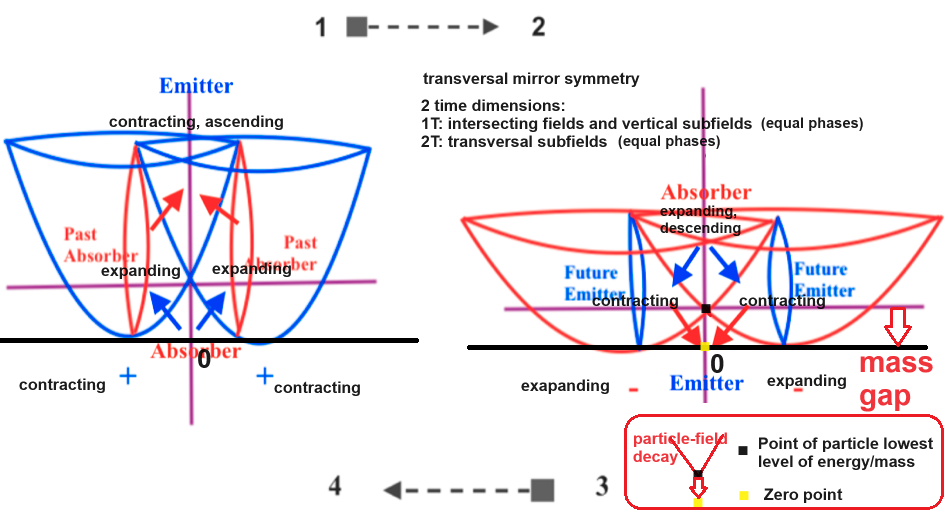
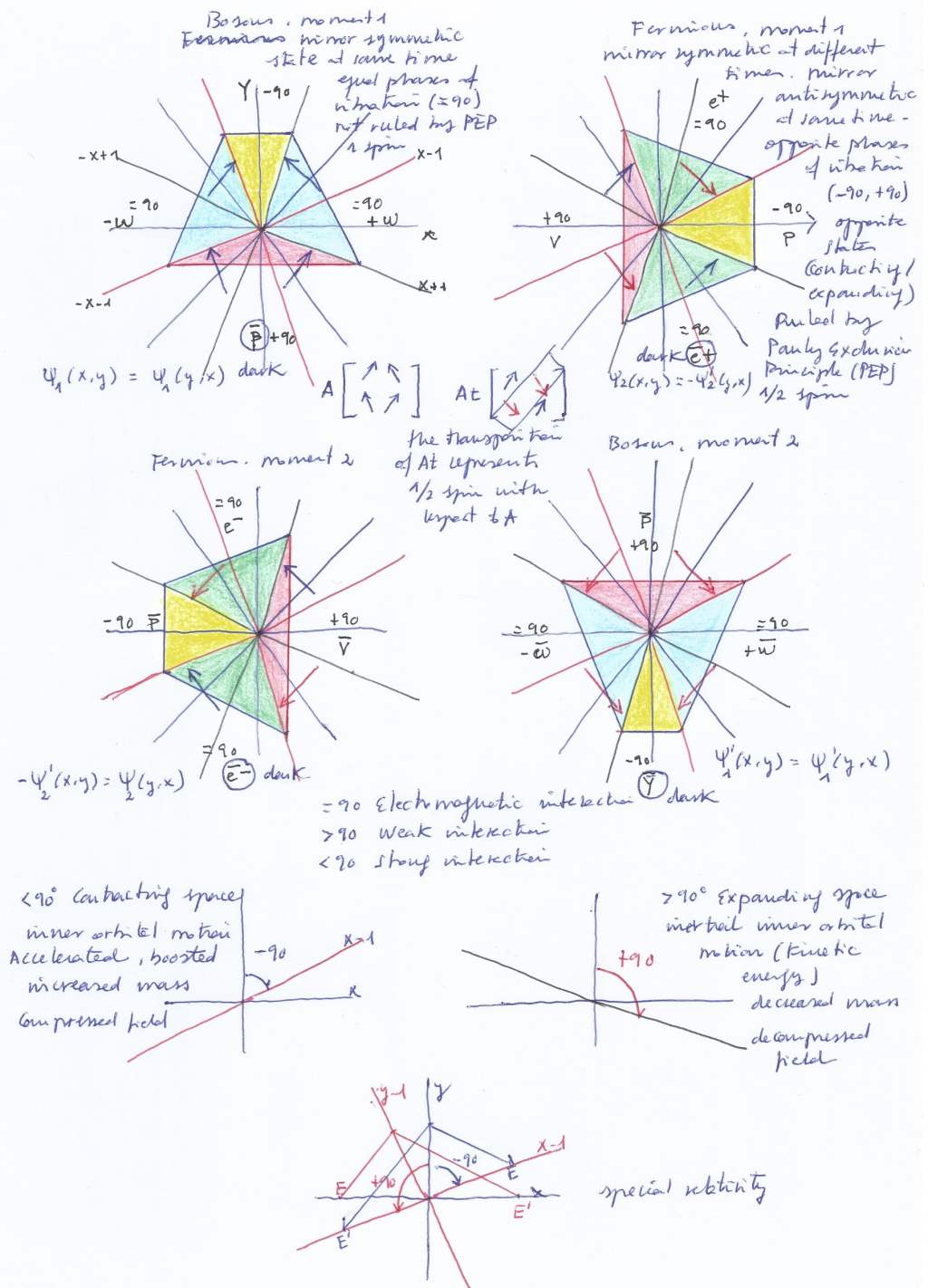
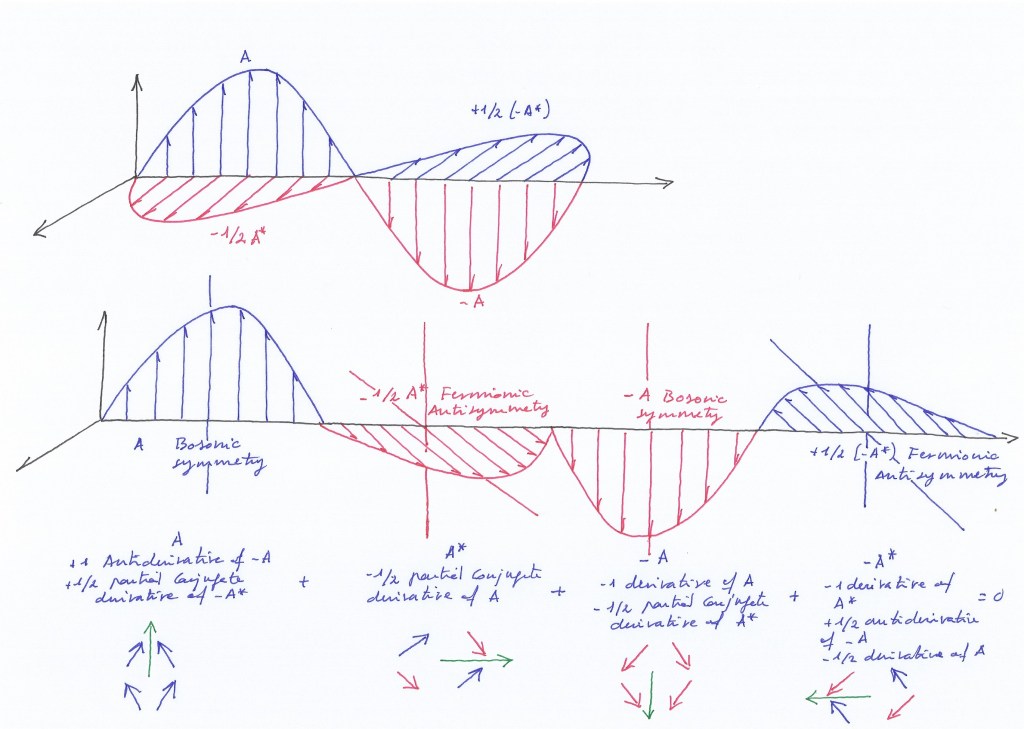
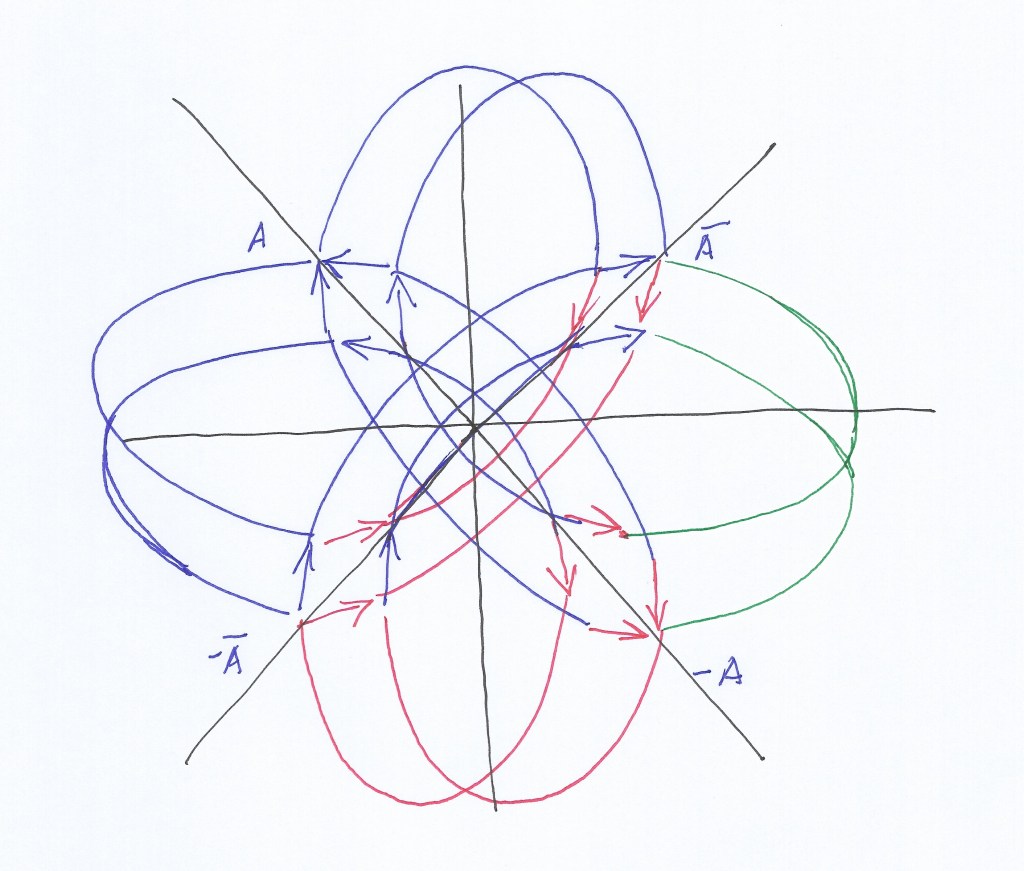



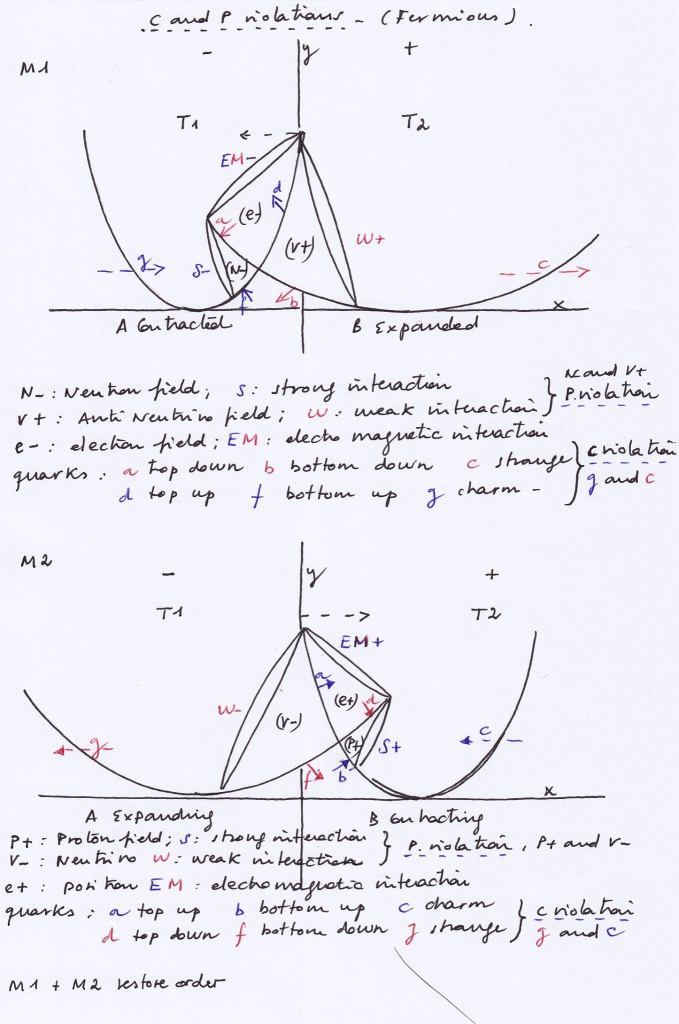
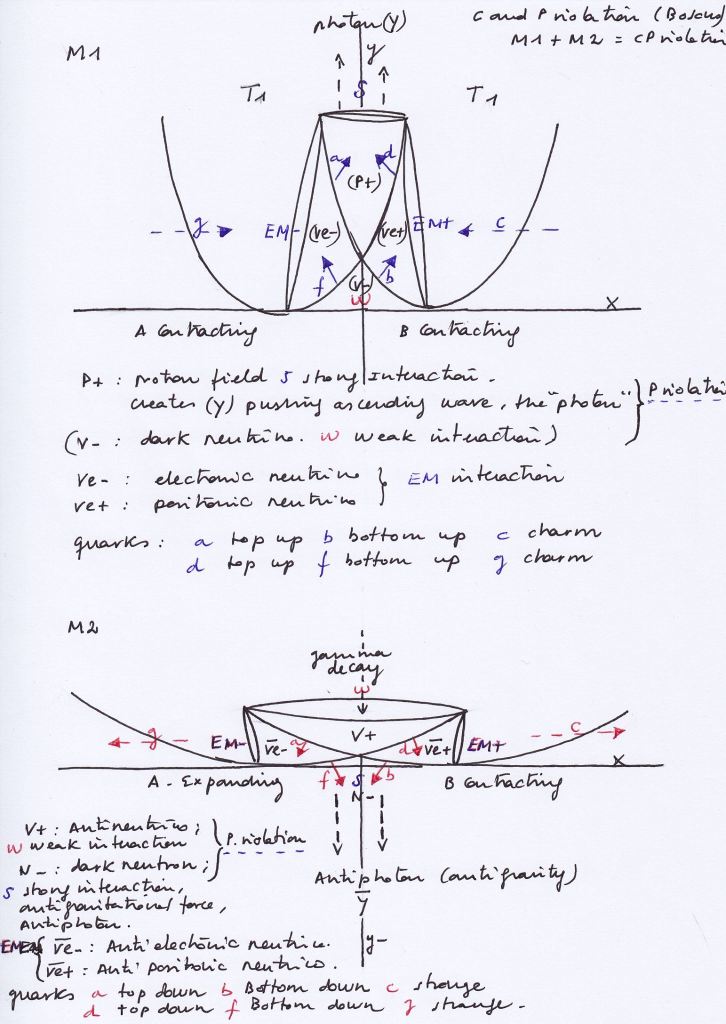
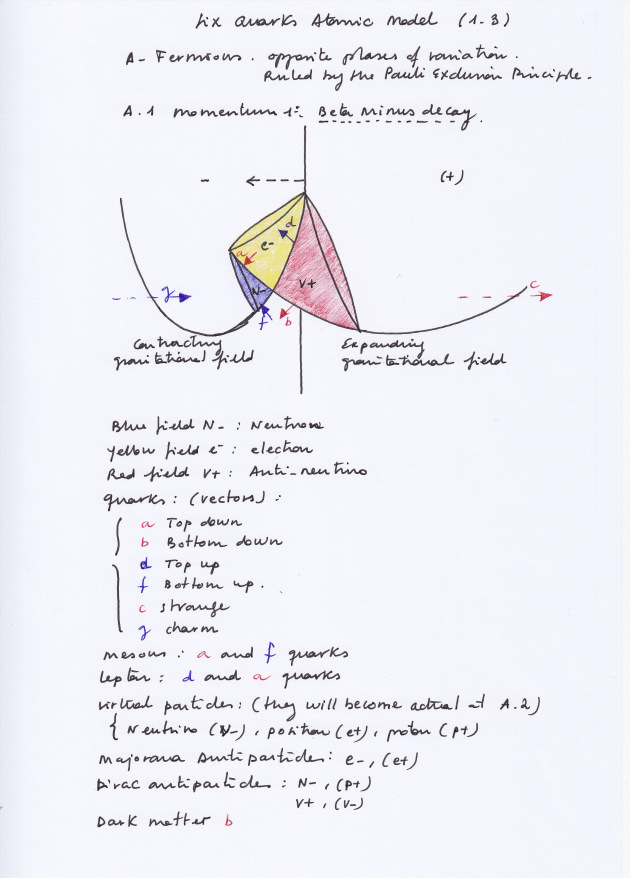
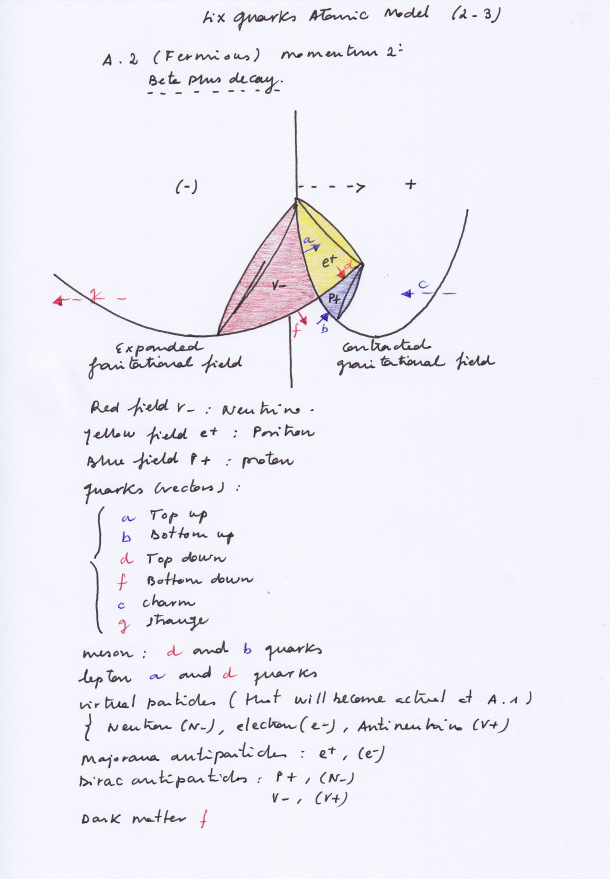
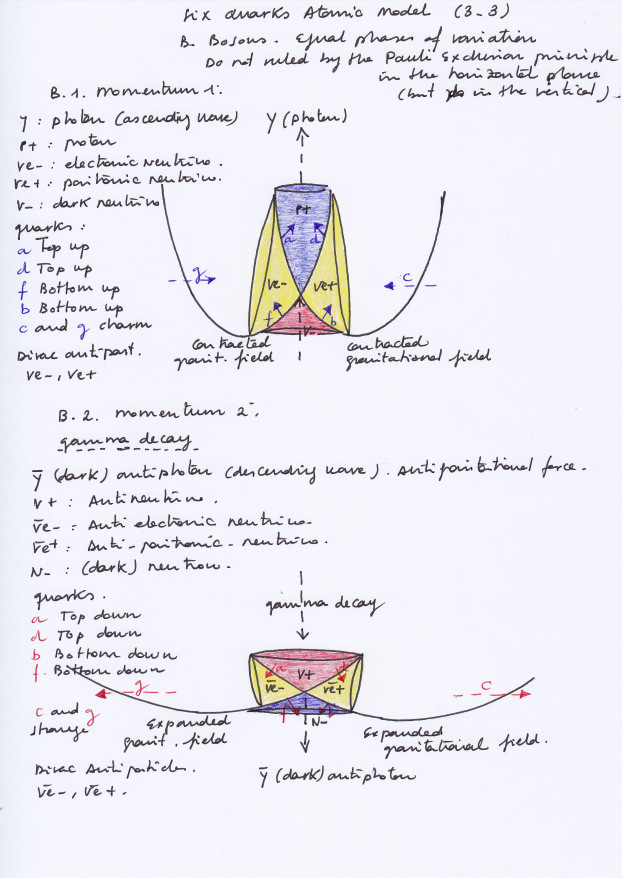
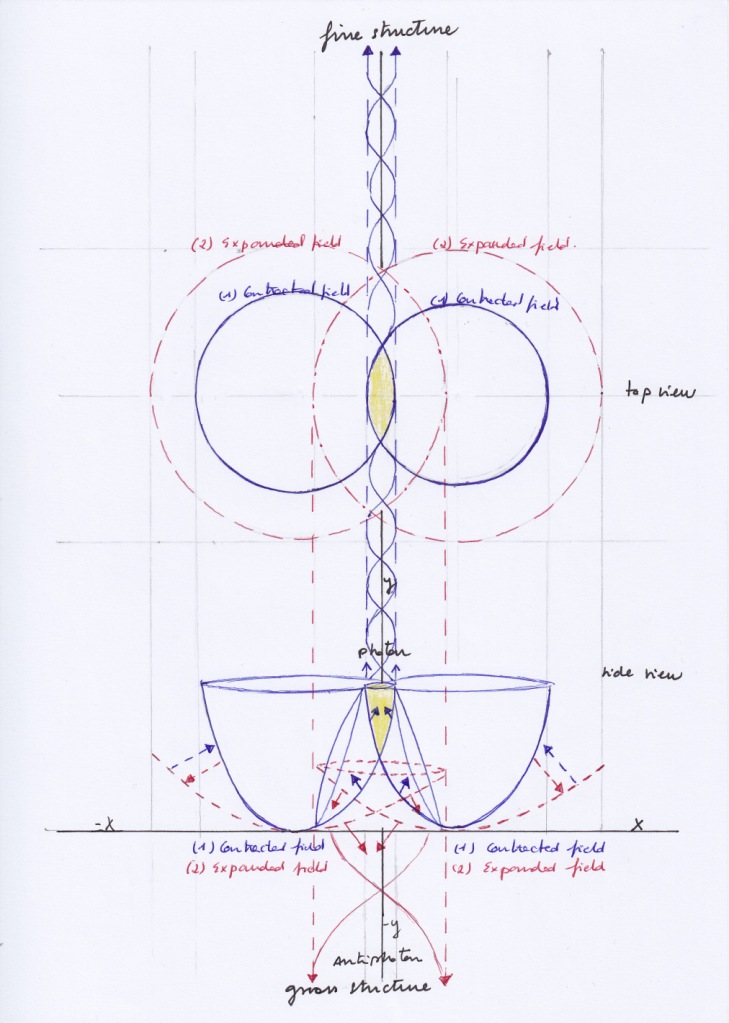
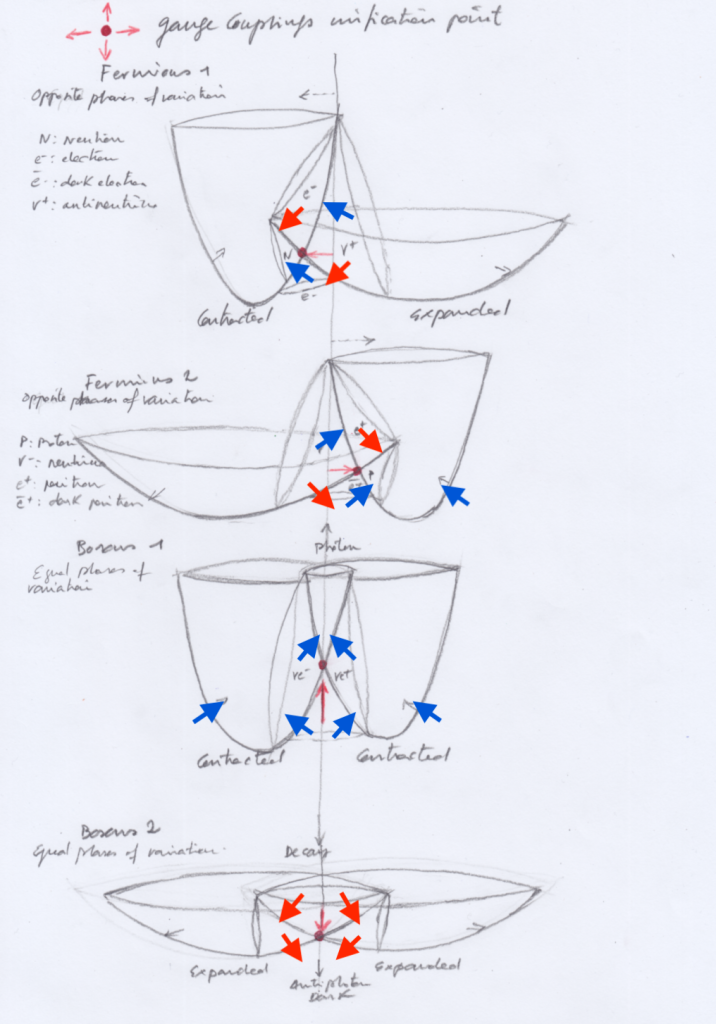
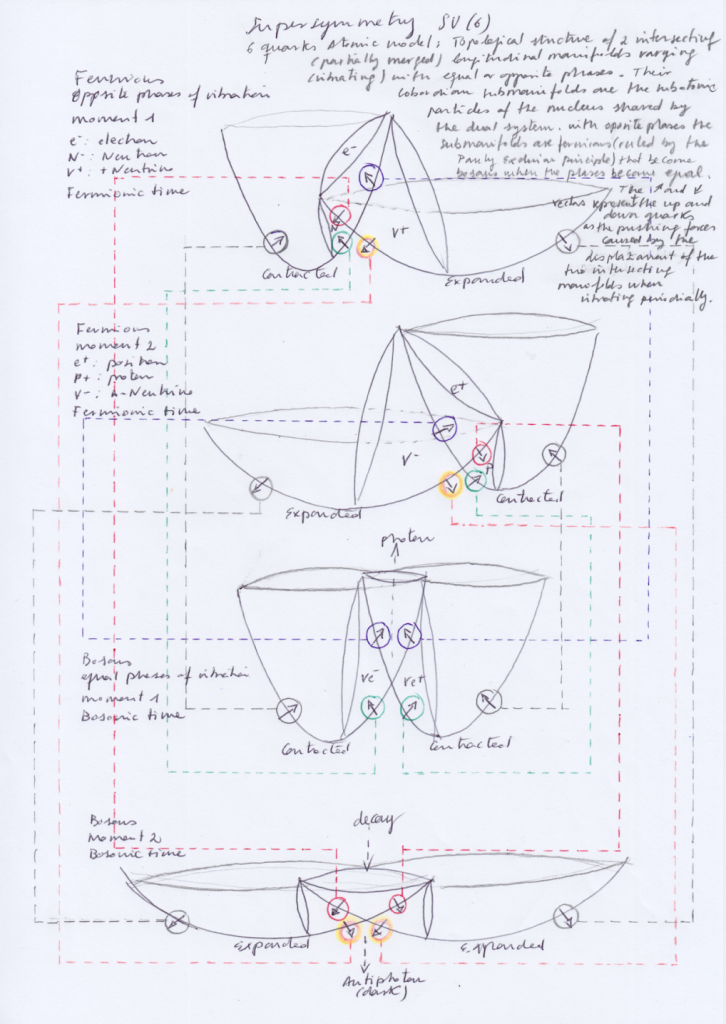

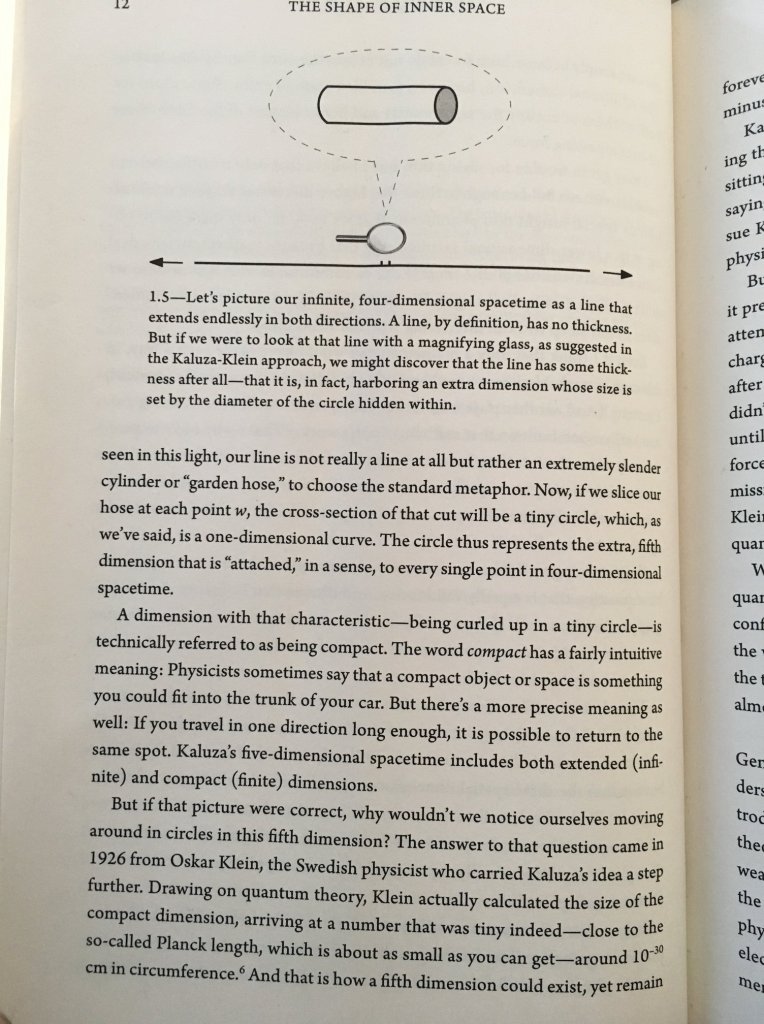
Escribe tu comentario